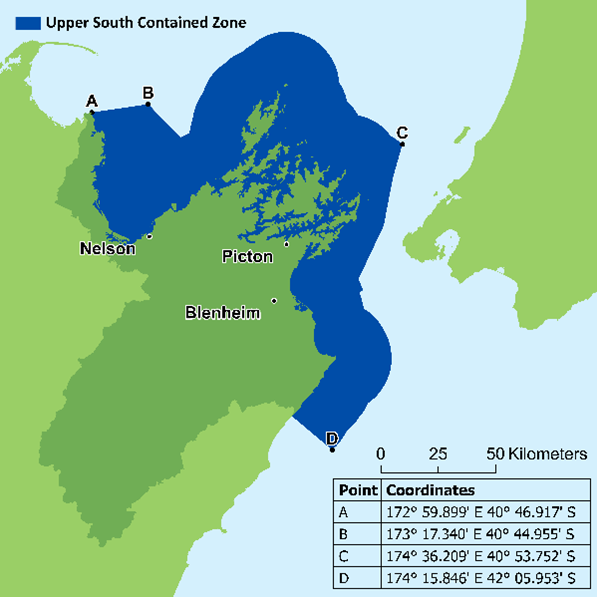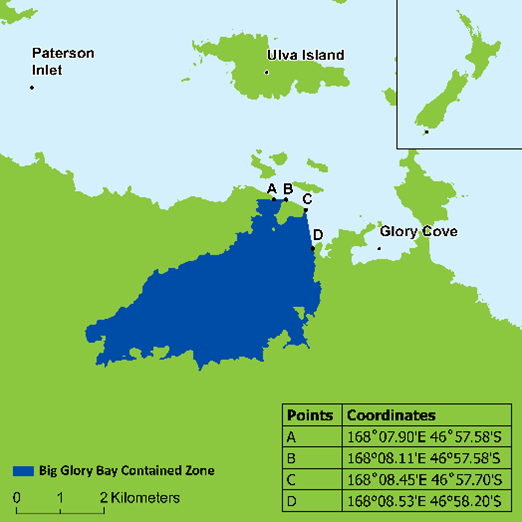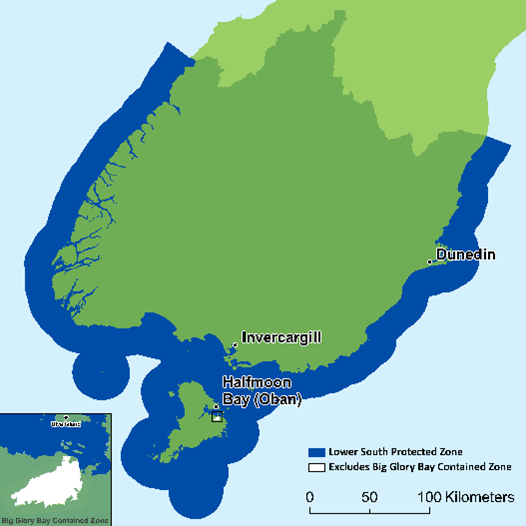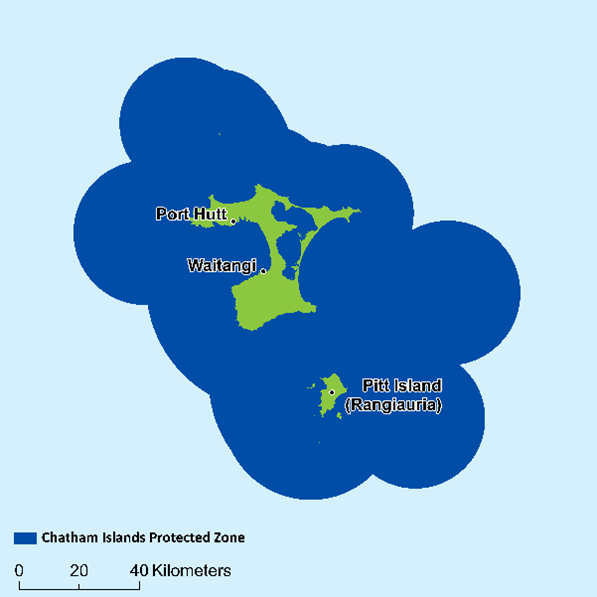1 November 2023
Reissued CAN retains existing restrictions
Following consultation with affected flat oyster farmers, we have reissued the Controlled Area Notice (CAN).
The reissued notice (effective 1 November 2023) retains the same restrictions that were in the CAN dated 1 September 2023 – we've made no changes.
Find out more about the CAN and the restrictions to stop the spread of bonamia
On this page
The Bonamia ostreae threat
Bonamia ostreae spreads through the movement of infected flat oysters. The parasite may be carried by other shellfish such as Pacific oysters, green lipped mussels and geoducks (a type of clam). It does not kill these shellfish, but they can pass it on to flat oysters. The parasite does not affect food safety of any shellfish.
Biofouling on vessels and equipment may spread the parasite.
To prevent its spread, there are legal controls in place on some boating and fishing activities in certain parts of the country.
About the Controlled Area Notice (CAN)
On 1 November 2023, we reissued the CAN that stipulates the legal restrictions in place to control the spread of Bonamia ostreae. The replacement CAN was issued after consultation with affected flat oyster farmers. It retains the same restrictions as the CAN dated 1 September 2023 with no changes. The CAN has rules for marine farm operators and recreational fishers in 4 specific areas of New Zealand:
- Upper South Island (Upper South)
- Big Glory Bay, Rakiura Stewart Island
- Lower South Island (Lower South)
- Chatham Islands
Bonamia ostreae Controlled Area Notice effective from 1 Nov 2023 [PDF, 1.3 MB]
Upper South contained zone
Upper South is a contained zone, which means we know Bonamia ostreae is here and we need to contain it within the zone (the area coloured blue on the map).

If you are in this zone, you must know and follow these CAN rules.
- Shellfish or shellfish waste (including shells) collected in the zone cannot be put in the sea anywhere outside the zone.
- Equipment used in the waters of the zone must not be moved out of the zone unless it is visibly free of fouling.
If you're a marine farm operator, refer to the new CAN for other rules that apply to you.
Controlled Area Notice effective from 1 Nov 2023 [PDF, 1.3 MB]
Big Glory Bay contained zone
Big Glory Bay is a contained zone, which means we need to contain Bonamia ostreae within the zone (the area coloured blue on the map).

If you are in this zone, you must know and follow these CAN rules.
- Flat oysters must not be moved into or out of the zone.
- Shellfish or shellfish waste (including shells) collected in the zone cannot be put in the sea outside the zone.
- Vessels must not be moved into or out of the zone unless the vessel is visibly clear of fouling, or if fouling is visible, an MPI permit is obtained prior to being moved.
- Gear must not be moved into or out of the zone unless it is visibly free of fouling.
If you're a marine farm operator, refer to the new CAN for other rules that apply to you.
Controlled Area Notice effective from 1 Nov 2023 [PDF, 1.3 MB]
Lower South protected zone
Lower South is a protected zone, which means we have not found Bonamia ostreae here and we need to keep it out of the zone (the area coloured blue on the map).

If you are in this zone, you must know and follow these CAN rules.
- Shellfish or shellfish waste (including shells) collected outside the zone must not be returned to the sea inside the zone.
- Gear must not be moved into the zone unless it is visibly free of fouling.
- Flat oysters and marine farm equipment used to harvest or rear flat oysters within 1 nautical mile of the coast of Stewart Island must not be moved within the Lower South Protected Zone for the purposes of aquaculture farming without a permit.
If you're a marine farm operator, refer to the new CAN for other rules that apply to you.
Controlled Area Notice effective from 1 Nov 2023 [PDF, 1.3 MB]
Chatham Islands protected zone
The Chatham Islands is a protected zone, which means we have not found Bonamia ostreae here and need to keep it out of the zone (the area coloured blue on the map).

If you are in this zone, you must know and follow these CAN rules.
- Shellfish or shellfish waste (including shells) collected outside the zone must not be returned to the sea inside the zone.
- Gear must not be moved into the zone unless it is visibly free of fouling.
If you're a marine farm operator, refer to the new CAN for other rules that apply to you.
Controlled Area Notice effective from 1 Nov 2023 [PDF, 1.3 MB]
Steps you can take to help stop the spread of bonamia
- Know and follow the new CAN rules.
- Keep your hull clean.
- Keep your gear clean.
- Put shellfish waste in the bin.
Know the new CAN rules
It is important you know the new CAN rules that came into force on 1 September 2023 – the same rules are in the replacement CAN issued on 1 November 2023.
Controlled Area Notice effective from 1 Nov 2023 [PDF, 1.3 MB]
Keep your hull clean
Remove any fouling (plant material and shellfish) as it can spread the parasite and other marine pests. A slight layer of slime and barnacles is okay – but nothing else.
Keep your gear clean
Pull weeds off any fishing, diving or other gear that you take out of the water and put it back in the sea before you move on, because they can also spread the parasite and other marine pests. If you find something on your gear later, in a new location, do not put it in the sea. Place it in a plastic bag and put it in the rubbish back on land.
Put shellfish waste in the bin
After eating, put the shells and other waste in the rubbish back on land. Diseased shellfish may look healthy – but even their empty shells can spread the parasite.
Putting the waste in the rubbish stops it getting into uninfected waters and spreading disease.
Movement permits
You may need a permit to move restricted shellfish, stock, or marine farm equipment and craft, into or out of zones covered by the CAN.
If you have questions about permits or the CAN, email bonamiacontrol@mpi.govt.nz
Report it if you think you’ve seen it
It can be hard to spot the disease caused by Bonamia ostreae. Common symptoms to look for in oysters are:
- poor condition
- gills that look corroded
- yellow discolouration of the gills and mantle.
Bonamia ostreae can also cause widespread flat oyster deaths.
The public, aquaculture farmers, and fishers should keep an eye out for these signs. If you see anything suspicious, contact Biosecurity New Zealand by:
- calling our Exotic Pest and Disease Hotline – 0800 80 99 66, or
- making a report online
What we are doing about bonamia
A bonamia programme governance group led by Biosecurity New Zealand oversees the management of Bonamia ostreae. Representatives on the governance group include:
- Fisheries New Zealand
- Environment Southland
- Awarua Runaka
- Southland District Council
- Aquaculture New Zealand
- the Bluff wild oyster fishery.
The objective of the programme is to protect uninfected wild oyster populations from Bonamia ostreae.
Download the terms of reference of Bonamia Programme Governance group [PDF, 384 KB]
The Bonamia programme activities include:
- Twice-yearly surveillance to monitor for the presence of Bonamia ostreae.
- Management of the Controlled Area Notice to reduce the risk of Bonamia ostreae spreading.
- Development of biosecurity guidance for flat oyster farming, which outlines biosecurity considerations for the possible location of flat oyster farms.
In late 2022, we completed a targeted consultation on the revised Controlled Area Notice and the proposed Biosecurity policy (later referred to as guidance).
Download the summary of the feedback on the targeted consultation [PDF, 989 KB]
Surveillance reports
Report on the Bonamia ostreae Survey 23 Autumn 2024 surveillance [PDF, 11 MB]
Report on the Bonamia ostreae Spring 2023 Surveillance [PDF, 4.2 MB]
Report on the Bonamia ostreae Autumn 2023 Surveillance [PDF, 6.4 MB]
Report on the Bonamia ostreae Spring 2022 surveillance [PDF, 3.1 MB]
NIWA report of surveys from February 2019 to March 2021 [PDF, 720 KB]
Technical reports
Return to flat oyster farming – Technical Advisory Group report [PDF, 1.3 MB]
Bonamia governance group preliminary recommendations [PDF, 444 KB]
Domestic spread of Bonamia – risk advice [PDF, 2.8 MB]
Get the latest updates
Subscribe to the Bonamia newsletter
Who to contact
If you have any questions about Bonamia, email bonamia.liaison@mpi.govt.nz








